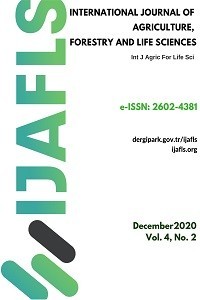Malvaceae spp. leaves as a novel crop for food
Malvaceae spp. leaves as a novel crop for food
green leaves, Malva Lavatera, nutritional value, traditional food, novel crop,
___
- Allen, P., Van Dusen, D., Lundy, J., and Gliessman, S. (1991). Integrating social, environmental, and economic issues in sustainable agriculture. American Journal of Alternative Agriculture, 34–39.
- Bar-Tal, A., Yermiyahu, U., Beraud, J., Keinan, M., Rosenberg, R., Zohar, D., Rosen, V., and Fine, P. (2004). Nitrogen, phosphorus, and potassium uptake by wheat and their distribution in soil following successive, annual compost applications. Journal of Environmental Quality 33, 1855-1865.
- Barazani, O., Mayzlish-Gati, E., Lifshitz, D., Hadas, R., Keren-Keiserman, A., Golan, S., Faraj, T., Singer, A., Beerman, A., and Perevolotsky, A. (2017). Strategies and priorities in field collections for ex situ conservation: the case of the Israel Plant Gene Bank. Genetic Resources and Crop Evolution 64, 1-5.
- Barazani, O., Perevolotsky, A., and Hadas, R. (2008). A problem of the rich: Prioritizing local plant genetic resources for ex situ conservation in Israel. Biological Conservation 141, 596-600.
- Barros, L., Carvalho, A.M., and Ferreira, I.C.F.R. (2010). Leaves, flowers, immature fruits and leafy flowered stems of Malva sylvestris: A comparative study of the nutraceutical potential and composition. Food and Chemical Toxicology 48, 1466-1472.
- Bouriche, H., Meziti, H., Senator, A., and Arnhold, J. (2011). Anti-inflammatory, free radical-scavenging, and metal-chelating activities of Malva parviflora. Pharmaceutical Biology 49, 942-946.
- Dafni, A. (1985). Edible plants of the land of Israel. Tel-Aviv (Hebrew): The Society for the Protection of Nature in Israel.
- Guarrera, P.M. (2003). Food medicine and minor nourishment in the folk traditions of Central Italy (Marche, Abruzzo and Latium). Fitoterapia 74, 515-544.
- Gupta, A.K. (2004). Origin of agriculture and domestication of plants and animals linked to early Holocene climate amelioration. Current Science 87, 54-59.
- Hanningtonkiff, J.G. (1984). Poisonous Plants in Britain - and Their Effects on Animals and Man - Cooper,Mr, Johnson,Aw. Lancet 2, 556-556.
- Krispil, N. (1983–1989). Bag of plants (Hebrew). Jerusalem: Yerid Hasefarim.Mariotti, F., Tome, D., and Mirand, P.P. (2008). Converting nitrogen into Protein - Beyond 6.25 and Jones' factors. Critical Reviews in Food Science and Nutrition 48, 177-184.
- Mayer-Chissick, U., and Lev, E. (2014). " Wild edible plants in Israel tradition versus cultivation. ," in Medicinal and Aromatic Plants of the Middle-East, eds. Z. Yaniv & N. Dudai. (Dordrecht: Springer), 9-26.
- Neves, J.M., Matos, C., Moutinho, C., Queiroz, G., and Gomes, L.R. (2009). Ethnopharmacological notes about ancient uses of medicinal plants in Tras-os-
- Montes (northern of Portugal). Journal of Ethnopharmacology 124, 270-283.
- Ozcan, T. (2006). Total protein and amino acid compositions in the acorns of Turkish Quercus L. taxa. Genetic Resources and Crop Evolution 53, 419-429.
- Sethi, S. (2015). Bread, Wine, Chocolate: The Slow Loss of Foods We Love. New York: HarperCollins.
- Shelef, O., Fernández-Bayo, J. D., Sher, Y., Ancona, V., Slinn, H., & Achmon, Y. (2018). "Elucidating Local Food Production to Identify the Principles and Challenges of Sustainable Agriculture," in Sustainable Food Systems from Agriculture to Industry ed. C.M. Galanakis. 1st ed (London, United Kingdom: Elsevier Inc.), 47-81.
- Shelef, O., Weisberg, P.J., and Provenza, F.D. (2017). The Value of Native Plants and Local Production in an Era of Global Agriculture. Frontiers in Plant Science 8.
- Team, R.C. (2019). R: A language and environment for statistical computing.
- Vermunt, J., and Visser, R. (1987). Nitrate Toxicity in Cattle. New Zealand Veterinary Journal 35, 136-137.
- Zarcinas, B.A., Cartwright, B., and Spouncer, L.R. (1987). Nitric-Acid Digestion and Multielement Analysis of Plant-Material by Inductively Coupled Plasma Spectrometry. Communications in Soil Science and Plant Analysis 18, 131-146.
- Yayın Aralığı: Yılda 2 Sayı
- Başlangıç: 2017
- Yayıncı: Volkan OKATAN
The effect of particle sizes on ammonium adsorption kinetics and desorption by natural zeolites
Veli UYGUR, Canan ŞANLI ÇELİK, Enise SUKUSU
Geographical indication of turkish food products in the process of accession to the european union
Effects of fig seed flour on some quality parameters of cookies
Lorena ZUDAİRE, İnmaculada VİÑAS, Tomas LAFARGA, Lucia PLAZA, Gemma ECHEVARRİA, Gloria BOBO, Rosa ALTİSENT, İngrid AGUİLÓ-AGUAYO
Yin Yin KYAWT, Achara LUKKANANUKOOL, Min AUNG
Investigation of some blackberry cultivars in terms of phenological, yield and fruit characteristics
